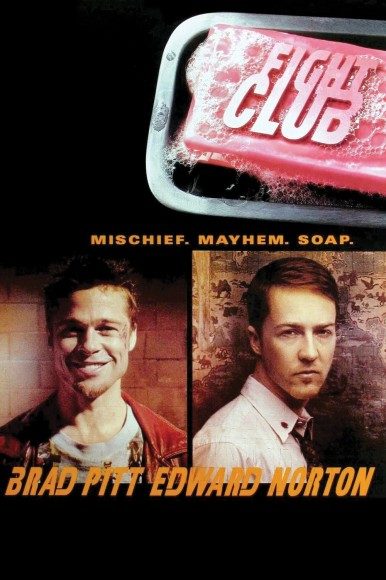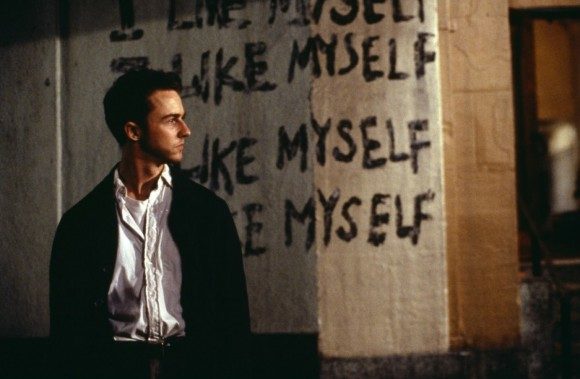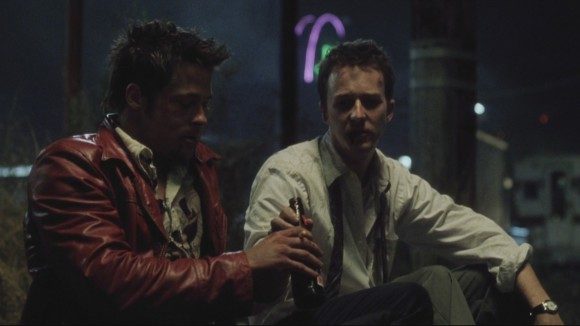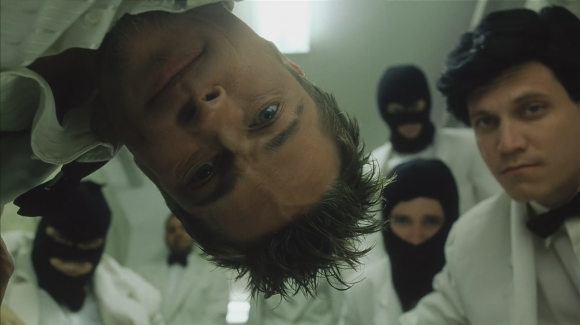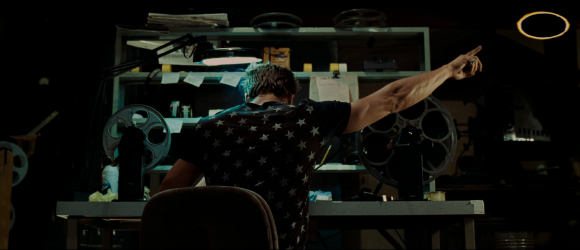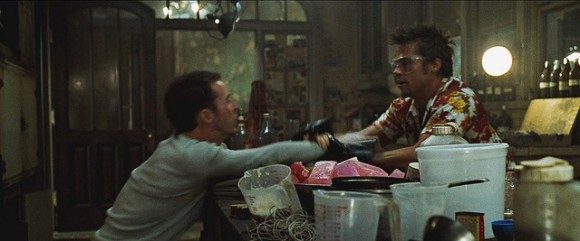“You can call that irresponsible. Or you can call it the only essential Hollywood film of 1999.” Thus concludes Time Out’s review of Fight Club, and, in a kind of terrifyingly prescient way, those two sentences offer up a more apt summation of the decade and a half’s worth of discussion the movie has inspired than anything we could come up with. Is it just a nihilistic anti-think piece that glorifies violence? Or is it actually an incisive satire of that very attitude? A call to action, a rallying cry to shake off the shackles of complacency? A masterpiece of cinematic storytelling? Any of these things? All of them? None of them?
At the very least, it’s impossible to argue that the film hasn’t been a provocative piece of work. It’s become one of those cinema conversation starters – we assume everyone around us who is at least moderately film-literate has already seen it, and we look forward to exchanging notes on our individual reactions. “Did you ‘get’ the film? Did you get it too much? Was there even anything to get? Did you know the twist going in? What is the point?” Now, after fifteen years of Fight Club as a cultural object, how does Fight Club the film hold up?
It’s undeniable that the 2014 viewing experience is radically different from the 1999 viewing experience, and not just because of the cultural cache that the film has acquired in the interim. Fincher’s film felt like a coalescence of various themes and preoccupations that were just in the air at the time of its release. Consider the cinematic landscape of 1999. In March audiences were introduced to The Matrix and invited to question how much they could trust their senses, their memories, and the world around them. August saw the release of The Sixth Sense and its unforgettable, film-changing third act twist. September offered up American Beauty and a vision of the traditional Americana model of success and values that was despairingly hollow and void of meaning. In December Magnolia asked, “How can we keep healthy relationships with those around us while we lose our own heads?” And sandwiched in the middle of all that was Fight Club, a movie that brought together all of these preoccupations, turned the volume up to eleven, and then set it all on fire.
The talent roster behind the film has become so ubiquitous in contemporary filmmaking that it takes a second to remember how different our perceptions of these men would have been at the time of the film’s release. Brad Pitt was a rising star, but his track record was mostly built on sensitive pretty boys, with the occasional off-kilter performance added for color. Edward Norton had just roared into the scene with Rounders and American History X, but he was mostly an unknown chemical at that point. Even director David Fincher was a bit of a cypher, with only one bona fide hit and two very unsettling semi-flops to his name. In many ways, this is the film that cemented the images we would come to know these men by. We see the first take of Pitt as sexy, devil-may-care Captain Cool. Norton is the volcanically neurotic everyman. And we feel Fincher as the clinically incisive master surgeon of cinema.
It’s also a film that could not have been made even a few years after its release. Fight Club is clearly a product of a time of great prosperity, when, lacking external factors to blame for the problems in our lives, we turned on ourselves. The characters show an extremely blasé disregard for things like employment or financial security, and bemoan the lack of a unifying cultural tragedy (à la Vietnam) for their generation. The film runs on paranoia, but it’s aimed not at an outside force like governments or big business; rather, it targets the characters’ own actions and what they’re capable of. It’s a film that was clearly produced in late Clinton-era America, the one that existed before the Great Recession, the War on Terror, and 9/11.
If I bring up just how rooted in the cultural milieu of 1999 Fight Club feels, it’s mostly to highlight how impressive it is that the film still works for the most part. Like the best pieces of art, it feels reflective of a time without being dependent on it. It creates a microcosm of a rampantly consumerist end-of-the-millennium America for the viewer to sink into, and by the time we’re immersed in it we are perfectly centered on the time period the film is critiquing. The first half hour of Fight Club remains a tour-de-force in establishing character and tone. Its unique cocktail of non-chronological storytelling, self-referential voiceover, onscreen text, cancer support group infiltration, subjective visions, subliminal flashes, and mid-air airplane collision fantasies don’t just introduce us to the world, they coil us into the skittish, claustrophobic position its narrator lives in. By the time the film is done grounding us, we perfectly understand what is broken about this man and his way of life, even if that is no longer, or ever was, our way of life.
A big part of this robustness comes directly from Fincher’s command of the frame, and in terms of scene construction and presentation of information, Fight Club remains a cinematic warhorse. By now it’s almost a film school stereotype to call Fincher’s style “dispassionate” or “cold.” Looking at his recent films, there is an austerely journalistic tone to Zodiac and The Social Network that seems to morph very little when moving over into a beautiful-but-distant feeling for The Curious Case of Benjamin Button. But even after experiencing those films, Fight Club stands out as an example of clockwork precision filmmaking. Pay attention to the flow of visual and audio information the next time you visit the film. Rack focuses are so carefully timed to coincide with action, freeze frames are so exactingly chosen, and voiceover lines dovetail so neatly into dialogue that you start to feel like the film was shot by metronome and cut by scalpel.
The feeling that blankets the film is undoubtedly a cold one… but I think this works in part to balance out the film’s loopy violence and bizarre content (more on that later). If anything, as the film has aged and I’ve gotten more acclimated to its bursts of ultraviolence, I’ve become more and more aware of how humorous it is, largely thanks to its formal trickery. The script for Fight Club (available here if anyone is curious) is an engaging but largely unfunny read. The film experience, however, is a barrel of rich, cinematic laughs coming not from lines or situations but from expert uses of freeze frames, matching cuts, sudden appearances and disappearances, jarring sound effects, and perfectly timed interplay between the film world and fourth-wall breaking elements.
But even without the more complicated tricks, Fincher is constantly able to extract comedy from the cinematic apparatus. Consider the scene where anonymous club members are trying to pick fights with strangers. It’s a small montage and the actions themselves are not particularly comical, but the way in which they’re shot, from three static, unchanging shots, and intercut, at a brisk pace that’s perfectly timed with the music to give the viewer a sense of repetition, makes it uproarious. The film remains weirdly unheralded for its comedic chops, even though it’s a far better example of cinematic humor than most so-called comedies released today, and feels like an evolutionary precursor to the inventive visual flair of directors like Edgar Wright.
But all right, let’s get down to brass tacks and the two things that I know you all care the most about: how does the film’s third act twist and it’s uncomfortably ambiguous thematic content hold up fifteen years after its release?
The film’s third act twist (and spoiler alert, by the way) has long been a point of contention for many fans. Members of the public have criticized the revelation that the narrator and Tyler Durden are the same person since the film’s release. “It’s illogical! The film cheats by showing them together for so many scenes! There’s no way to figure it out until the film pulls the rug out from under your feet!”
Much has been written about the subtle ways in which the film actually plants visual and plot clues to what’s really going on, so I won’t go into much detail on that front. Seeing the film again recently, with the flabbergasting shock of the first few viewings dulled into a more discerning perspective, what struck me about the twist is how neatly it’s tied into the film’s formal manipulations. They makes a big fuss about how Tyler works with film, and about how he takes great pleasure in sneaking information into film screenings without the audience being the wiser. He gets them to see something without realizing it. He is always present when the film launches into its more overt cases of cinematic manipulation, from his one-frame flashes in the first twenty minutes to a particularly powerful speech of his that actually makes the edges of the frame flicker into visibility. From the start he is surrounded by formal artificiality, a conceit that sets up the groundwork for the revelation that his very existence is a literal result of manipulative filmmaking. How well we accept the twist may well remain a matter of personal proclivity, but the more the initial shock fades away, the more the film’s adherence to its own internal mechanics and rules becomes apparent.
But the big point of debate over Fight Club has always been on its philosophical and thematic leanings. What is the ideological worldview that this film is presenting? Is it advocating the use of violence to free ourselves from the limiting complacency of our daily lives? How much of the long stretches during which the film preaches the use of such extreme measures should be taken at face value? The official company line from David Fincher and the makers of the film is that Fight Club should be read as a The Graduate-style coming-of-age story, complete with its seductive tempter that is embraced and then rejected, and that its cult-like depiction of aggression is meant to be taken as satire. That’s certainly how some people took it in 1999, but many others did not. Some saw it an amoral advocate for meaningless violence, and other misguided souls bought the “satire” wholesale and actually started living life the Tyler Durden way. But that was all the way back in 1999. That’s practically the Stone Age! Since then we’ve gotten more genre savvy, more post-modern, more, dare I say it, ironic – now we navigate through this film, no problem, right?
Well… kind of. Reflecting on it at a distance, you can clearly see the design that Fincher intended for Fight Club to be built on. It’s no accident that the film opens with half an hour of the Narrator attending support groups for the grievously ill; once we start to go into the Fight Club ideology we do so knowing that the character for whom this is working is so broken that the last thing that gave him an emotional outlet was faking debilitating sicknesses en masse. Tyler Durden is clearly supposed to be a character that reads as likable until the film yanks our leash back and reminds us that he is a sociopath. The scenes in which this pullback happens, like when he blithely threatens to kill an innocent shopkeeper on a whim or his bloody appeal to bar owner Lou, are distinctly unpleasant experiences, ranging from the tensely unsettling to the viscerally revolting. You remember the points where you were supposed to feel the magic spell weakening and cracking before it collapses entirely in the third act.
Living the film is a different matter, however, and there is a distinct feeling throughout the film that it is worshipful of Tyler Durden and his psychotic philosophy. Even when we see him doing something appalling, he feels so in control of the film that it’s difficult to not get swept up in his influence. Consider the famous chemical burn scene. It’s a masterfully arranged scene, one that clearly conveys the horror of what is happening to Edward Norton and translates the conflict between the two men’s outlooks into visual terms. Watch the way in which the skittish jump cuts, disorganized flashes, and haphazard jumps of Norton’s perspective give way to the long, steady shots of Pitt’s as the Narrator comes to accept what is being done to him. Intellectually we are outraged, but in cinematic terms we are being pushed into aligning with Durden. Fincher does such a good job of taking the anarchist’s viewpoint and translating it into a compelling cinematic experience that he doesn’t really leave us much space to call that experience into question. It’s a seamless filmic experience, but one that perhaps runs away from its director’s stated intent.
The problem is that when we snap out of the film’s deranged spell somewhere around its third act we remember how much the world has grown since 1999, and the problems and concerns that pushed the characters into these extreme views feel all the more juvenile and baseless. Our connection to the film’s thematic core is less immersive that it was back then, and its subversive movements don’t feel as relevant. The film remains an outstanding exercise in style, cinematic comedy, and unification of plot, form, and theme. It’s that last element, however, where the years have been most unkind to the film. Perhaps at the time of its release, the concerns and worries it was addressing were so present that it merited the film pushing the envelope and blurring the lines to such an extreme degree, but over time the ends have gotten less visible and the means have started to feel less justified. Fight Club has always been a great ride, but one that leaves you unsure of where you started when you got on and where you ended up as you dismount. Perhaps that lingering insecurity was part of the design, but over the past fifteen years that feeling has gotten more pronounced, and one suspects it’ll only grow stronger over the next fifteen.

